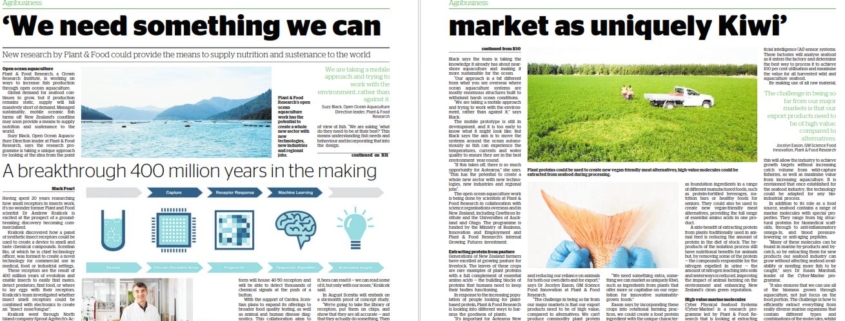Agribusiness Report: Plant & Food working to increase fish production
Open ocean aquaculture
Plant & Food Research, a Crown Research Institute, is working on ways to increase fish production through open ocean aquaculture.
Global demand for seafood continues to grow, but if production remains static, supply will fall massively short of demand. Managed sustainably, mobile oceanic fish farms off New Zealand’s coastline may soon provide a means to supply nutrition and sustenance to the world.
Suzy Black, Open Ocean Aquaculture Direction leader at Plant & Food Research, says the research programme is taking a unique approach by looking at the idea from the point of view of fish. “We are asking ‘what do they need to be at their best?’ This means understanding fish needs and behaviour and incorporating that into the design.
Black says the team is taking the knowledge it already has about near-shore aquaculture and making it more sustainable for the ocean.
“Our approach is a bit different from what you see overseas where ocean aquaculture systems are mostly enormous structures built to withstand harsh ocean conditions.
“We are taking a mobile approach and trying to work with the environment, rather than against it,” says Black.
The mobile prototype is still in development, and it is too early to know what it might look like. But Black says the aim is to move the systems around the ocean autonomously so fish can experience the temperatures, currents and water quality to ensure they are in the best environment year-round.
“If this takes off, there is so much opportunity for Aotearoa,” she says. “This has the potential to create a whole new sector with new technologies, new industries and regional jobs”.
The open ocean aquaculture work is being done by scientists at Plant & Food Research in collaboration with science organisations overseas and in New Zealand, including Cawthron Institute and the Universities of Auckland and Otago. The programme is funded by the Ministry of Business, Innovation and Employment and Plant & Food Research’s internal Growing Futures investment.
Extracting protein from pasture
Generations of New Zealand farmers have excelled at growing pasture for livestock. The leaves of these crops are rare examples of plant proteins with a full complement of essential amino acids — the building blocks of proteins that humans need to keep their bodies functioning.
In response to the increasing population of people looking for plant-based protein, Plant & Food Research is looking into different ways to harness the goodness of plants.
“It’s important for Aotearoa New Zealand’s economic future that the food industry develops new plant-based food options for consumers, creating a wider portfolio of products and reducing our reliance on animals for both our own diets and for export,” says Dr Jocelyn Eason, GM Science Food Innovation at Plant & Food Research.
“The challenge in being so far from our major markets is that our export products need to be of high value, compared to alternatives. We can’t produce commodity plant protein ingredients, like pea or soy protein ingredients, for export as our competitors operate at scales we cannot achieve.
“We need something extra, something we can market as uniquely Kiwi, such as ingredients from plants that offer more or capitalise on our reputation for innovative sustainably-grown foods.”
Eason says by incorporating these crops into rotational farming practices, we could create a food protein ingredient with the unique characteristics needed for the New Zealand food industry and with positive sustainability credentials.
Proteins from plants could be used as foundation ingredients in a range of different manufactured foods, such as protein-fortified beverages, nutrition bars or healthy foods for seniors. They could also be used to create new vegan-friendly meat alternatives, providing the full range of essential amino acids in one product.
A side-benefit of extracting protein from plants traditionally used in animal feed is reducing the amount of protein in the diet of stock. The by-products of the isolation process still have nutritional benefits for animals but, by removing some of the protein — the compounds responsible for the nitrogen expelled in urine — the amount of nitrogen leaching into soils and waterways is reduced, improving the impact of animal farming on the environment and enhancing New Zealand’s clean green reputation.
High value marine molecules
Cyber Physical Seafood Systems (Cyber-Marine) is a research programme led by Plant & Food Research that is looking at extracting high-value molecules from seafood during processing. The idea is to create automated multi-operation flexible factories, monitored by artificial intelligence (AI) sensor systems. These factories will analyse seafood as it enters the factory and determine the best way to process it to achieve 100 per cent utilisation and maximise the value for all harvested wild and aquaculture seafood.
By making use of all raw material, this will allow the industry to achieve growth targets without increasing catch volume from wild-capture fisheries, as well as maximise value from increasing aquaculture. It is envisioned that once established for the seafood industry, the technology could be adapted for any bio-industrial process.
In addition to its role as a food source, seafood contains a range of marine molecules with special properties. They range from big structural proteins for biomedical scaffolds, through to anti-inflammatory omega-3s, and blood pressure-lowering or anti-aging peptides.
“Many of these molecules can be found in marine by-products and by-catch, so by extracting them for new products our seafood industry can grow without affecting seafood availability or needing more fish to be caught,” says Dr Susan Marshall, leader of the Cyber-Marine programme.
“It also ensures that we can use all of the biomass grown through aquaculture, not just focus on the food portion. The challenge is how to efficiently extract everything from really diverse marine organisms that contain different types and combinations of the molecules, whilst not destroying one component to recover another.”
● Case studies supplied by NZ Plant and Food Research



